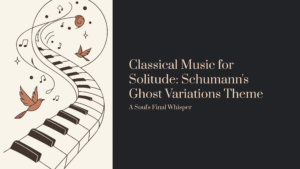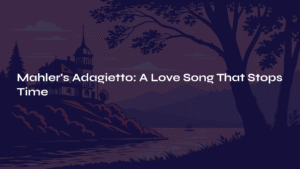Table of Contents
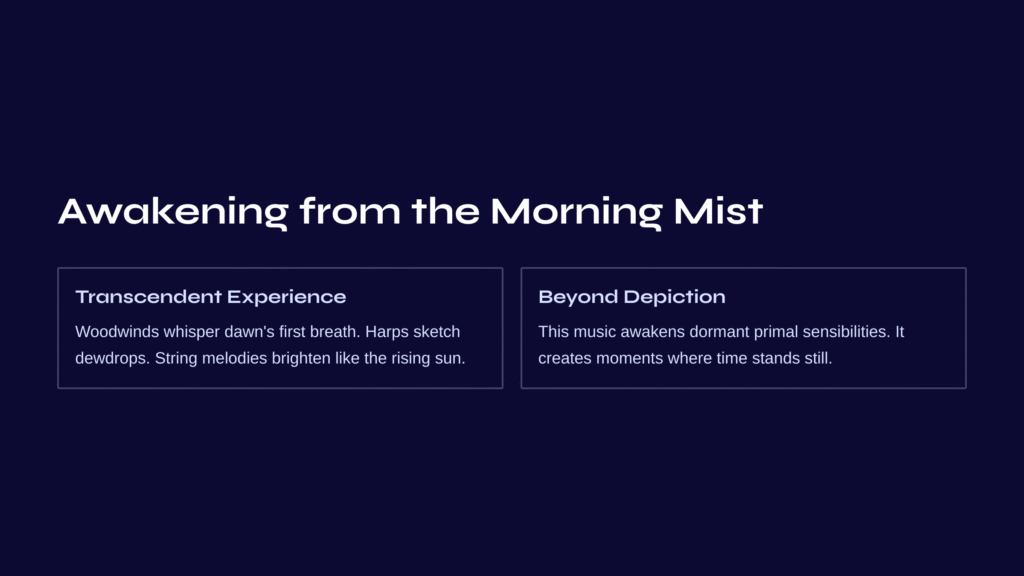
Awakening from the Morning Mist
Some music transcends time and touches the deepest corners of our hearts. When I first heard the opening movement ‘Daybreak’ from Ravel’s Daphnis et Chloé Suite No. 2, I felt as though I was slowly opening my eyes in the morning mist of a sacred forest. The woodwinds whispering the first breath of dawn, harps sketching dewdrops, and string melodies brightening like the gradually rising sun.
This music goes beyond merely depicting nature—it awakens the primal sensibilities that lie dormant within us. Have you ever experienced those moments while listening to music when time seems to stand still? Ravel’s ‘Daybreak’ contains exactly that kind of magic.
The piece doesn’t just paint a sonic picture of sunrise; it resurrects something ancient and essential in our souls, something we’ve perhaps forgotten in our modern rush through life.
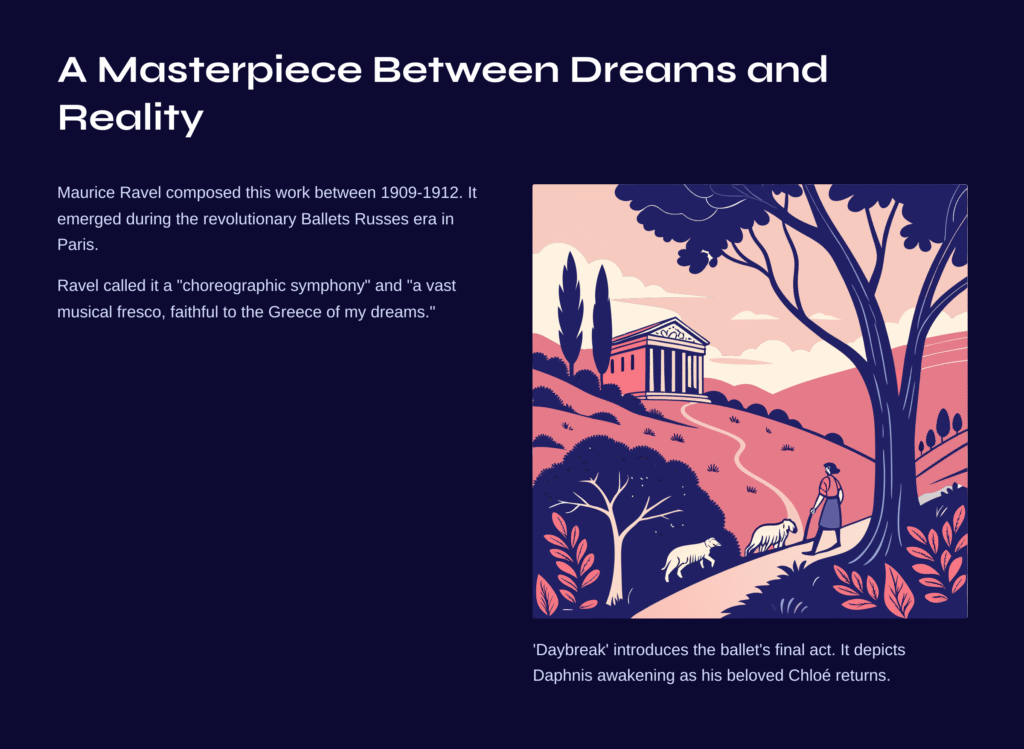
A Masterpiece Born Between Dreams and Reality
Maurice Ravel composed Daphnis et Chloé between 1909 and 1912, during the era when Sergei Diaghilev’s Ballets Russes was revolutionizing the Parisian art scene. Ravel called this work a “choreographic symphony,” intending not simply to create ballet music, but to construct an entire world through sound alone.
As Ravel himself described it, this music was “a vast musical fresco, faithful to the Greece of my dreams”—not the actual ancient Greece, but the idealized pastoral landscape imagined by late 18th-century French painters.
The ‘Daybreak’ movement serves as the introduction to the ballet’s final act, depicting the moment when Chloé, who had been kidnapped by pirates, is rescued through Pan’s divine intervention and reunited with Daphnis. It captures that sacred instant when the shepherds find Daphnis sleeping before the nymphs’ grotto and awaken him, just as his beloved Chloé appears—a moment of divine reunion.
This wasn’t merely programmatic music for Ravel; it was his attempt to capture something universal about love, loss, and the eternal cycles of separation and reunion that define human experience.
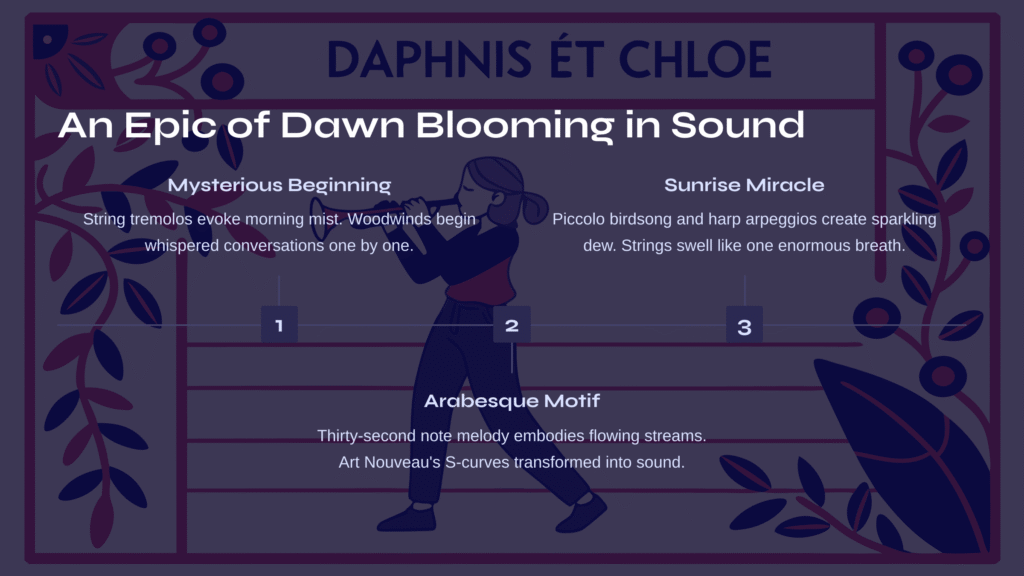
An Epic of Dawn Blooming in Sound
Miracle Beginning from Silence
‘Daybreak’ consists of just 77 measures—relatively brief—yet the musical density contained within is remarkably profound. The piece begins like slowly awakening from deep sleep, emerging from mysterious silence. Gentle string tremolos evoke morning mist while woodwinds begin their whispered conversations one by one.
One of Ravel’s most beautiful innovations here is the arabesque motif played in thirty-second notes. This melody initially sounds like simple ornamentation, but gradually emerges as the musical centerpiece, perfectly embodying flowing streams and nature’s whispers. Like Art Nouveau’s S-curves transformed into sound, this melody’s repeated descents and ascents contain the very breath of life itself.
The genius lies in how this seemingly decorative element becomes structurally essential—what musicologist Gurminder Kaur Bhogal identified as evolving from ornament to “rhythmic, formal, and narrative catalyst,” particularly crucial at the moment of Daphnis’s awakening.
The Magic of Sunrise
The sunrise scene occurring in the piece’s middle section represents a true miracle of orchestration. Piccolo birdsong, harp arpeggios creating sparkling dew, and strings swelling like one enormous breath—all layering together to recreate that majestic moment when the sun crests the horizon.
Ravel employed two harps to achieve rich sonorities without complex pedal changes, while offstage wordless chorus creates the effect of nature itself singing. This isn’t merely technical cleverness, but the musical embodiment of a pastoral worldview where human, natural, and divine elements harmonize as one.
The orchestration here represents what Stravinsky called Ravel’s “Swiss clockmaker” precision—every detail calculated yet sounding utterly spontaneous, creating what scholars term “acoustic illusion” through the seamless blending of timbres and textures.
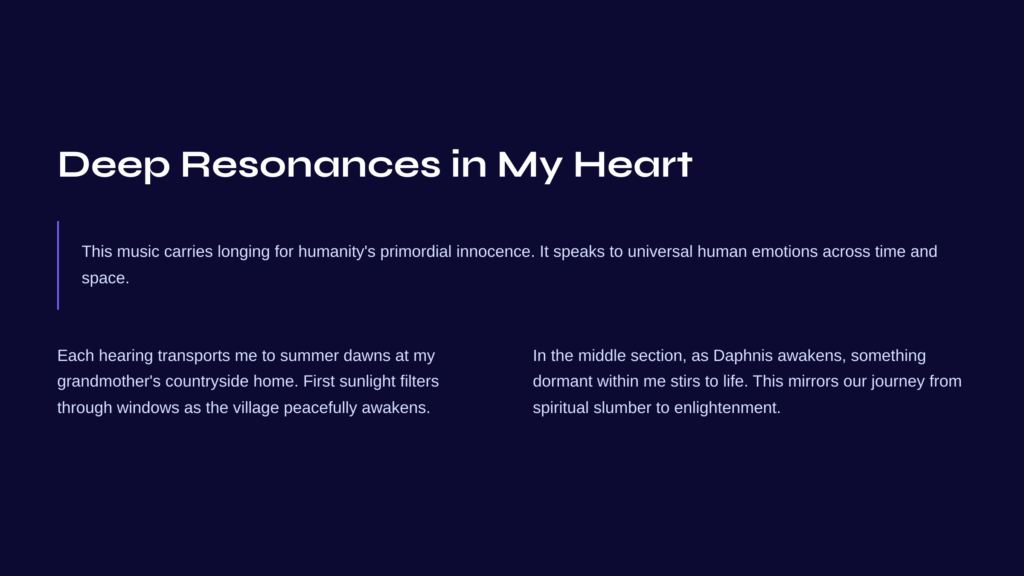
Deep Resonances in My Heart
Each time I hear this music, I’m transported to summer dawns at my grandmother’s countryside home—first sunlight filtering through windows, roosters crowing as the village peacefully awakens. But Ravel’s ‘Daybreak’ touches memories far deeper than personal nostalgia.
This music carries longing for humanity’s primordial innocence, when we lived as one with nature’s rhythms. Everything civilization has caused us to lose—the reverence and humility of an age when we moved with natural cycles—permeates every note. Chloé and Daphnis’s love story is merely the surface; the true theme is humanity’s return to its fundamental home.
Particularly in the middle section, where the arabesque motif moves to the foreground depicting Daphnis’s awakening, I feel something dormant within me stirring to life as well. This is precisely the power of great music—its ability to speak directly to universal human emotions across time and space.
There’s something profound about how Ravel captures that liminal moment between sleep and waking, between unconsciousness and awareness, that seems to mirror our own journey from spiritual slumber to enlightenment.
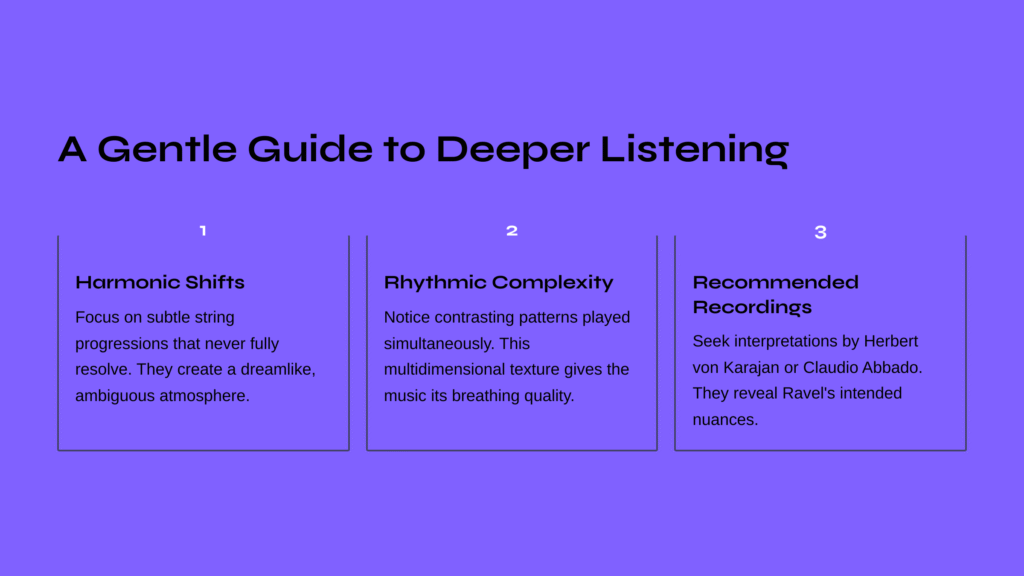
A Gentle Guide to Deeper Listening
To fully experience Ravel’s ‘Daybreak,’ I recommend focusing on several key elements.
First, listen carefully to the subtle harmonic shifts the strings create in the opening section. Ravel achieved that dreamlike state through floating harmonic progressions that never fully resolve, creating an ambiguous yet beautiful atmosphere that forms the piece’s essence.
Second, concentrate on the polyrhythmic complexity where different instrumental groups simultaneously play contrasting rhythmic patterns—triplet sixteenth notes, regular sixteenth notes, and triplet eighth notes creating multidimensional rhythmic texture that gives the music its breathing, living quality.
Finally, if possible, seek out recordings by Herbert von Karajan or Claudio Abbado, whose interpretations particularly reveal the subtle nuances and timbral blending Ravel intended. These conductors understand how to make the orchestra breathe as one organism while maintaining the delicate transparency essential to impressionist music.
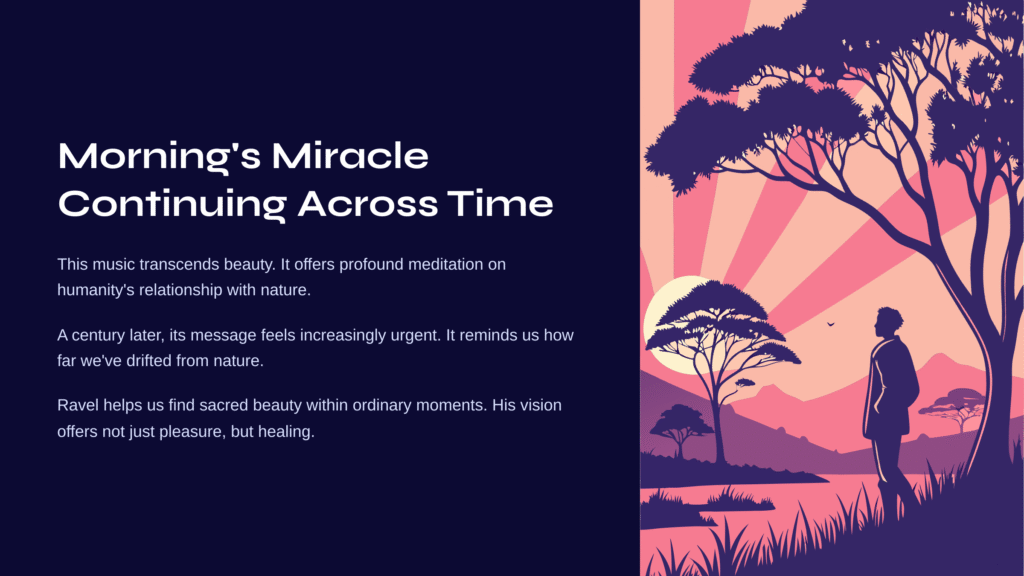
Morning’s Miracle Continuing Across Time
Ravel’s Daphnis et Chloé Suite No. 2 ‘Daybreak’ transcends beautiful music—it offers profound meditation on humanity’s primordial relationship with nature and expresses our deepest longing for lost innocence.
More than a century has passed, yet this music’s message feels increasingly urgent. It quietly reminds us how far we’ve drifted from nature, and how desperately we need to recover that connection.
The sun rises every morning as natural phenomenon, but through Ravel’s musical lens, we discover the hidden miracle and wonder within that daily event. This is precisely what great art gives us—special vision to find sacred beauty within ordinary moments, and those eternally continuing instances of transcendent emotion.
In our age of environmental crisis and spiritual disconnection, Ravel’s vision of harmony between human consciousness and natural rhythms offers not just aesthetic pleasure, but a kind of healing—a reminder of what we can become when we align ourselves with forces greater than our individual egos.
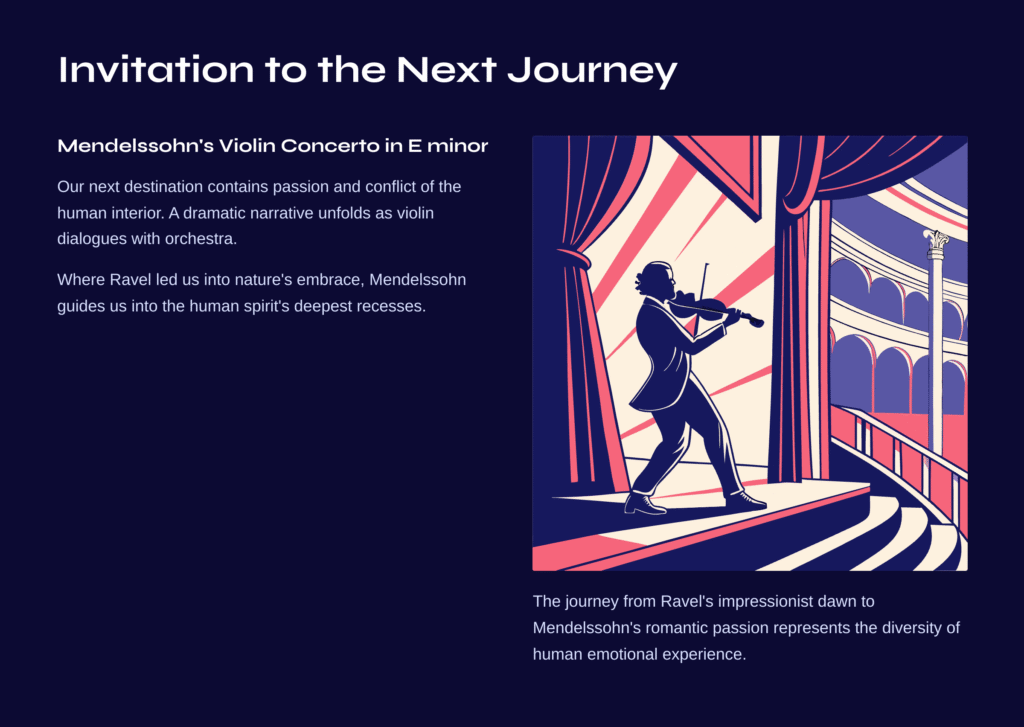
Invitation to the Next Journey: Mendelssohn’s Violin Concerto in E minor
After experiencing Ravel’s mystical dawn world, shall we venture into an entirely different emotional spectrum? Felix Mendelssohn’s Violin Concerto in E minor, first movement, awaits as our next destination.
If Ravel’s ‘Daybreak’ sings of pastoral peace where nature and humanity unite, Mendelssohn’s Violin Concerto contains the passion and conflict of the human interior, along with the will to transcend these struggles. Here we find dramatic narrative unfolding as a single violin dialogues with the entire orchestra—romantic melodies hiding deep inner turmoil, moments of doubt and uncertainty, and finally achieved catharsis.
Where Ravel led us into nature’s embrace, Mendelssohn will guide us into the deepest recesses of human spirit. Through these two composers’ different eras and approaches to musical truth, we can explore even more deeply the infinite worlds that classical music contains.
The journey from Ravel’s impressionist dawn to Mendelssohn’s romantic passion represents the beautiful diversity of human emotional experience—from our connection to the natural world to our wrestling with purely human concerns of love, longing, and artistic expression.

